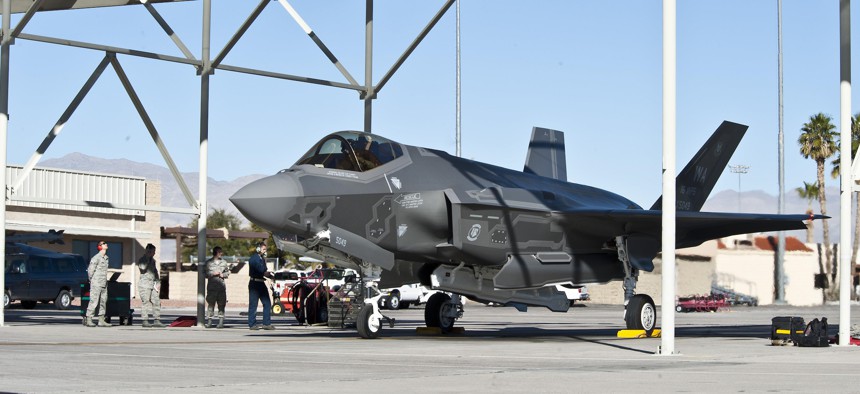
An F-35 at Nellis Air Force Base, Nev. The Air Force Small Business Innovation Research program paid a small business to create an F-35 abrasion-resistant coating that lasts 20 times as long as a previous coating. Air Force / Airman 1st Class Mikaley Towle
The Pentagon Must Pay More than Lip Service to Innovative Companies
The military has poured billions of dollars into the Small Business Innovation Research program — yet resists putting its fruits to use.
America’s economy generally rewards “creative disruption” — Amazon, Uber, and Tesla are great examples. The Defense Department, by and large, does not. Thanks to decades-old patterns of politics and protectionism, smaller innovators are discouraged from entering DOD markets, a condition that imperils our nation in an era of rapid technological change by adversaries in every operating domain. Should we fail to transform how the DOD conducts business, says the 2018 National Defense Strategy, we will soon field a Joint Force armed with systems irrelevant to our defense.
First, we need to understand why the DOD resists large innovations. Current DOD stakeholders are vested in long expensive acquisition cycles, with established budgets, personnel, and protocol. Small entrepreneurial companies are not and, if they had the opportunity, would rush to offer alternatives.
There is, in fact, already a mechanism within the DOD that would provide for entrepreneurial innovative disruption. The Small Business Innovation Research, or SBIR, Program is a congressionally authorized effort to attract small high-technology companies to federally sponsored research and development. Designed to foster innovative disruption, it feeds more than $1 billion annually to thousands of capable innovative companies. Yet it has produced few signs of significant creative disruptions. The SBIR Program acquisition rules offer agencies extraordinary flexibility to rapidly scale SBIR innovations. All competition requirements for commercializing SBIR innovations are satisfied by the competitions to originate and validate the innovations. The law even requires DOD agencies to use program awardees to the greatest extent practicable when continuing with R&D or production of their SBIR-derived technologies. Yet despite this extraordinary acquisition flexibility, the DOD fails to grow SBIR companies to fill critical needs in its industrial base.
This failure is because the DOD plays “small-ball” with its SBIR Program. Agencies are happy to let SBIR companies originate and validate their innovations, but less enthusiastic about letting them grow to displace current incumbencies some of which are within the DOD—clearly a conflict of interest. It is also not apparent that the DOD understands the intent of the SBIR Program or the boom in innovation that would result if SBIR companies were given the support to run with their innovation. The shifting of significant market share to companies who identify and deliver innovation is the only effective competitive pressure to dislodge current incumbencies from protecting the status quo.
It is telling that despite about 2,000 SBIR Phase I and II awards annually over the last two decades totaling nearly 40,000 awards and about $15 billion, and with extraordinary Phase III acquisition preferences that enable DOD agencies to grow SBIR companies around their SBIR-developed technologies, we do not find the expected growth of SBIR Phase III companies. In fact, I would challenge anyone to name a “home run” SBIR company, one that is driving innovation and change throughout DOD as they exist in commercial markets.
Even more frustrating are the reports from SBIR companies that DOD agencies use the Program to “out” and “vet” ideas — then pursue them with incumbent providers. This is in direct contradiction of the purpose of the SBIR Program and discourages companies from engaging with DOD. Several companies also make it to Phase III only to be left without a customer, a pathway, or an advocate to fully bring their technology or product to the DOD commercial market. Once an innovation has been developed and is being pursued within the DOD, it is essential that department commit to use that company to the greatest extent practicable. Without this assurance, companies will not engage or succeed. But a DOD culture that fosters and rewards innovation will attract the best and the brightest entrepreneurial innovators.
When pressed about why the DOD and the services are not enthusiastically pursuing SBIR innovations, agencies provide spurious reasons. They say helping SBIR companies to commercialize their innovations in the DOD market is a slippery slope to a future vendor-locked arrangement. The argument is a red herring: an unlikely and extreme hypothetical conjured up to protect incumbent providers and current processes. We need to worry more about engaging our country’s best innovators in national security and less about whether the small business will become a monopoly.
This week, I will speak at the Reagan National Defense Forum about ways to foster this essential innovation. Make no mistake: the competitive advantage that is narrowing between the U.S. and China and Russia will have real world consequences to Western civilization. If we want to protect the freedoms enshrined in the Constitution and Bill of Rights, then we need to defend them. Part of this defense is truly engaging small-business innovation to provide the necessary leaps in technology that will keep our competitive advantage, make the DOD more efficient, and ensure that the U.S. continues to dictate the terms of warfare. I look forward to working with senior DOD leaders, members of Congress, and industry executives to help maintain U.S. superiority at land, sea and air.




